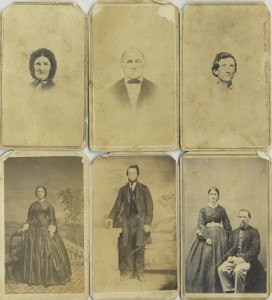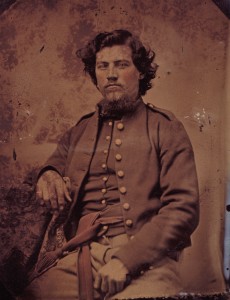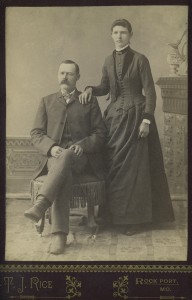Early Photograph Guide (1800’s)
Tintypes, Cartes de Visite (CdV), Cabinet Cards
- Introduced. Patented in 1854, gained prominence by 1856 as Neff’s Melainotype.
- Peak. Popularity varied through the life of the tintype. They saw limited success in Europe, but were commonplace in American homes for decades. Before the carte de visite, they were the only alternative to more expensive types of photograph. The civil war years (1861-1865) saw great popularity among the soldiers. Then in the 1890s they were popular as a quick and inexpensive image.
- Waned. 1900.
- Last Used. 1930s. For a long time from the late 19th century to as late as the 1930s itinerant tintype operators worked the back roads and county fairs. The tintype held on for so long because it was the only type of “instant photography” making it a popular item sold to tourists at seaside resorts and county fairs.
- Introduced. In November of 1854, the French photographer A.A. Disderi introduced a method for producing multiple images on a single glass plate, a format for mounting the resulting images on card stock and the name “carte de visite” to describe the product. Examples of cartes de visite before 1858 are extremely rare and are unlikely to be encountered outside of museums. The carte de visite began appearing in the United States late in the summer of 1859. By the end of 1860 the carte de visite had become the fashion throughout the country.
- Peak. The height of the “carte craze” was the period 1860-1866, which included the photography boom that occurred during the American civil war. The early 1860s period saw the first commercial photographic albums (the carte album), which began to grace ordinary middle class parlors. By 1864, a family would have to be poor indeed to not own a carte de visite album.
- Waned. Starting in 1866, the cabinet card began to erode the position held by the carte de visite. Carte production waned from 1870 to the late 1880s when they all but disappeared from the scene.
- Last Used. Cartes were, however, produced after 1900, perhaps to 1906 or perhaps in limited numbers to 1920 (unused card stock dating to the turn of the nineteenth-century can still be purchased from dealers in antique photographica).
- The dimensions of the standard Cabinet Card are 6½ x 4½.
- Introduced. In 1866, the Cabinet format was adapted for portraits.
- Peak. Although not uncommon in the 1870s, the cabinet card, however, did not displace the CdV completely until the 1880s.
- Waned. The 1890s witnessed the decline of the cabinet card and the card photograph album, replaced by the snapshot (an unmounted paper print) and the scrapbook album. A variety of other large card styles of various names and dimensions came about for professional portraits in the 1880s and 1890s. After 1900, card photographs generally had a much larger area surrounding the print. An embossed frame around the image, heavy, gray card stock and blind imprints were hallmarks.
- Last Used. The cabinet card was popular and continued to be produced until the early 1900s. The last cabinet cards were produced in the twenties, perhaps as late as 1924.
Tintypes
The advantages of the tintype were threefold: it created an unbreakable, durable, photographic image supported on an iron plate, which could be carried into hazardous conditions such as battle without breaking like the fragile daguerreotype; it was the first truly instant photograph, ready for the sitter in a few minutes; it was inexpensive, its lowered cost of production meant working class could own photographs. Indeed, the tintype remained popular at seaside resorts and county fairs well into the 20th century exactly because it was the only instant photograph available. The tintype had one of the longest periods of popularity of any early photograph type, lasting from the mid 1850s to the 1930s mostly at county fairs.
Timeline:

Lucy Chatfield, Isaac Herrick, unk Chatfield brother, Eliza Chatfield, unkn Chatfield, Eliza & Isaac Chatfield
Carte de Visite (CdV)
Description:
The carte de visite is easily recognized by the small card on which the photograph is mounted. In this format, a small paper photographic print is mounted on a commercially produced card. The carte de visite (commonly abbreviated to CdV) today is not a rare item, being produced by the millions in the nineteenth century.
The CdV image and card stock were both made to a standard size. The dimensions of the standard carte de visite mounting card were 2 1/2 x 4 inches. The standard dimensions of the CdV photograph (the image or print itself) were 2 1/8 x 3 1/2 inches.
Timeline:
Cabinet Card
The Cabinet Card has the appearance of a larger version of the carte de visite, retaining the photographer’s imprint and exhibiting similar styles of decorative artwork on the card face or back. Like the carte de visite, it consists of a paper photographic print mounted on commercially produced card stock of standard size.
Description
Timeline:
Source: CITY GALLERY website, founded in Aug 1995 by Steve Knoblock
Above Pictures:
Tintype: circa 1861: Isaac W. Chatfield, Civil War
Carte de Visite (CdV): Six CdV’s from a Chatfield family photo album
Cabinet Card: circa 1866/1867: Clark S. Chatfield, Sr. & 1st wife Louisa (Tankersley) Chatfield

